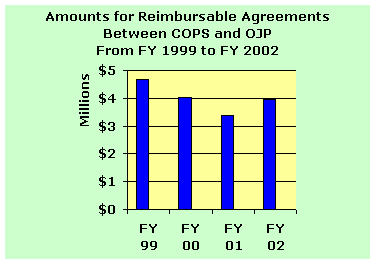
Source: OJP Audit Liaison
| Return to the USDOJ/OIG Home Page |
Streamlining of Administrative Activities and Federal Financial Assistance Functions in the Office of Justice Programs and the Office of Community Oriented Policing Services
Report No. 03-27
August 2003
Office of the Inspector General
FINDING 1: STREAMLINING THE OFFICE OF COMMUNITY ORIENTED POLICING SERVICES
From the beginning of the Office of Community Oriented Policing Services (COPS) in 1994, the COPS Office has relied on the Office of Justice Programs (OJP) to perform services related to the COPS program. In recent years the COPS Office's management and administration (M&A) costs per program dollar have been higher than OJP's. Also, the COPS Office's M&A costs per grant administered have increased, while OJP's M&A costs per grant administered have decreased. Moreover, we determined that the major COPS grants for hiring officers and civilians and for purchasing equipment, and the grants awarded by OJP under the Local Law Enforcement Block Grants (LLEBG) program overlapped, and no formal coordination existed between COPS and OJP to ensure grantees did not receive funds for similar purposes from both agencies. We also found that the COPS Office had not developed a capability to receive grant applications online and download the application information directly into its grant management system. Instead, grantees must submit applications and the application data must be manually input into the COPS's grant management system.
COPS Work Performed by OJP
While the COPS Office has responsibility for managing and administering the community oriented policing services program for the Department, the COPS Office has continually relied upon OJP to perform services related to the administration of COPS Office activities. The COPS Office's reliance on OJP began at the inception of the COPS program in 1994 and has grown since then. We identified the following ways that the COPS Office has relied on OJP:
A discussion of each way the COPS Office relies on OJP follows.
Initial COPS Grants Awarded by OJP. When the COPS Office was established in 1994, it turned to OJP for assistance in awarding the first COPS grants funded by Congress. Prior to passage of the 1994 Crime Act, Congress created the Police Hiring Supplement (PHS) grant program that provided funds to State and local governments to hire police officers. OJP's Bureau of Justice Assistance (BJA) was responsible for awarding and administering the PHS grants, which were awarded in 1994. Because the BJA was already established and experienced in awarding the PHS grants to State and local governments, the Department had the BJA award the first phase of COPS grants for the COPS Office. These were the 392 Phase I COPS hiring grants awarded in FY 1995, less than 3 weeks after the COPS Office was created, that allowed State and local governments to hire new additional police officers to perform community policing. Subsequently, the COPS Office went on the award about 7,000 grants during the remainder of FY 1995. The requirements of the Phase I grants were very similar to the requirements of BJA's PHS grants. The BJA's awarding of the Phase I COPS grants was the first in a continuing line of services performed by OJP for the COPS Office.
COPS Program Services Performed by OJP. Beginning in FY 1995, and continuing every year since, COPS has entered into reimbursable agreements with OJP to perform services related to the COPS program. As shown in the following chart, since FY 1999, the COPS Office has transferred a total of about $16 million in M&A costs to OJP through reimbursable agreements for OJP to perform services related to programs administered by the COPS Office.
According to OJP, the services it currently performs for the COPS Office are as follows:
We noted that the COPS Office has taken steps to reduce its use of OJP services by assuming responsibility for some functions previously performed by OJP such as: 1) reviewing and approving final grant award budgets, 2) providing financial management training to grantees, 3) coordinating with the OIG to resolve and close COPS grantee audit reports, and 4) assisting in negotiating repayment agreements with grantees and establishing payment schedules. Nonetheless, while the COPS Office has reduced the redundancies between the two agencies by using OJP to perform these services for the COPS program, the use of reimbursable agreements indicates that OJP is better suited to provide these functions for the COPS program.
COPS Funds Passed Through to OJP. In addition to the COPS Office relying on OJP to perform services related to the COPS program, the COPS Office has continually passed a portion of its funds to OJP to administer since FY 1999. The amount of funds passed through to OJP has steadily increased and reached almost 40 percent of COPS's total budget during FY 2002. As shown in the following chart, the trend has clearly been a steady decrease in the percentage of the COPS Office's budget managed and administered by the COPS Office.
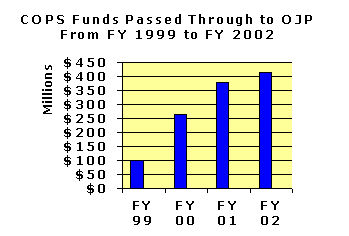
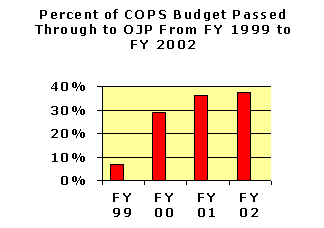
Source: OIG Analyses of Budget Data
COPS funds are passed through to OJP in various ways. Most of the funds passed through to OJP are mandated by Congress in the COPS Office's annual appropriations language, a practice that began in FY 1999.11 In FY 2002, the mandatory pass-through funds totaled $361.9 million. An example of a mandatory pass-through for FY 2002 was for the Police Corps program. In FY 2002, COPS's budget contained $14,435,000 for the Police Corps program. The Police Corps was created to help address violent crime by increasing the number of officers with advanced education and training who are assigned to community patrol. The central component of the Police Corps program is the provision of financial assistance and basic police training to college students who agree to serve as police officers for four years, along with financial assistance to participating police departments and sheriff offices. A second component offers no-obligation college scholarships to children of law enforcement officers killed in the line of duty. The authorizing language in the COPS Office's approved budget provided that the Police Corps funds would be transferred to OJP to administer. As such, the COPS Office passed through to OJP all $14,435,000 approved for the Police Corps program in FY 2002.
Another way the COPS Office passes through funds is through discretionary pass-throughs. Discretionary pass-throughs occur when the COPS Office and OJP agree that certain funds in the COPS Office's budget would be either best managed by OJP or best managed jointly and the COPS Office passes these funds to OJP at its discretion. For FY 2002, the discretionary pass-through funds totaled only about $387,000, which was substantially less than the $3.4 million in discretionary funds passed through to OJP in FY 2001. An example of a discretionary pass-through for FY 2001 was the jointly managed Comprehensive Indian Resources for Community and Law Enforcement (CIRCLE) program. The CIRCLE program is a three-year State initiative designed to empower American Indian communities to more effectively fight crime, violence, and substance abuse. In FY 2001, the COPS Office passed through $2 million to OJP to administer the CIRCLE program.
A third way that the COPS Office passes through funds to OJP is through earmarks. Earmarks are legislative directives in the appropriations laws that dictate how to spend certain portions of funds appropriated within larger funding programs. According to COPS officials, these funds are usually to continue projects previously administered by OJP or for programs that specifically fit within an existing OJP program. The legislative directives for the earmarks sometimes mandate that the funds be administered by OJP and at other times the COPS Offices passes through the earmark funds to OJP at its discretion. For FY 2002, the earmark funds passed through totaled $51.4 million. An example of an earmark for FY 2002 was to continue the Safe Schools Initiative (SSI) previously administered by OJP. The SSI supports a comprehensive, integrated community-wide approach to promote healthy childhood development and address the problems of school violence and drug abuse. In FY 2002, at its discretion, COPS passed through $9,531,000 of earmarked funds to OJP for the SSI. In most cases, once COPS passed through the funds, OJP assumed full responsibility for the management and administration of the funds.
Comparison of the COPS Office's and OJP's Costs to Manage and Administer Federal Financial Assistance Funds
The COPS Office and OJP both spend a large amount of money each year to manage and administer the Federal financial assistance funds awarded to State and local governments. From FY 1999 through FY 2002, Congress appropriated the COPS Office about $126 million in management and administration (M&A) costs to administer about $4.5 billion in program funds. During this same period, Congress appropriated OJP about $155 million in M&A costs to administer about $14 billion in program funds. We compared the M&A costs per program dollar spent and the M&A costs per grant administered for both the COPS Office and OJP for FY 1999 through FY 2002. As illustrated in the following charts, the COPS Office annually spends more M&A costs per program dollar than OJP. In addition, while the COPS Office has spent less M&A costs per grant administered than OJP, COPS's M&A costs per grant administered increased each year from FY 1999 to FY 2002, while OJP's M&A costs per grant administered decreased each year from FY 1999 to FY 2002. Moreover, if the trend continues, the COPS Office will likely spend more M&A costs per grant administered than OJP in FY 2004.
Comparison of Actual M&A Costs for COPS and OJP
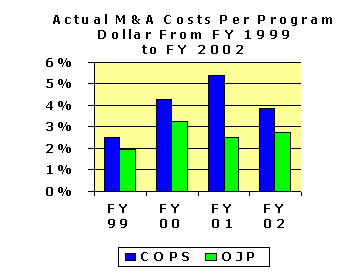
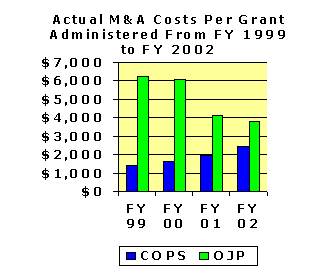
Source: OIG Analyses of Actual Costs and Grant Award Data
The COPS Office's M&A costs per grant administered are increasing because the COPS Office has not significantly reduced its personnel costs even though the grants administered by the COPS Office has significantly declined in recent years. OJP's M&A costs per grant administered are decreasing because OJP has kept its personnel costs relatively constant in recent years while it administered a significantly higher number of grants.12
Duplication Between COPS Grants and OJP Grants
In addition to reviewing the COPS Office's reliance on OJP and comparing the COPS Office's and OJP's M&A costs, we reviewed the types of grants awarded by the two agencies to determine if any duplication existed. We determined that the major COPS grants for hiring officers and civilians and for purchasing equipment were sometimes duplicative of grants awarded by OJP under the Local Law Enforcement Block Grant (LLEBG) program. While the LLEBG program is much broader in terms of what the program will fund, some of the allowable LLEBG expenditures are for the same purposes as the COPS Universal Hiring Program (UHP) grants, COPS Making Officer Redeployment Effective (MORE) grants, COPS in Schools (CIS) grants, COPS Safe Schools Initiative (SSI) grants, and COPS Secure Our Schools (SOS) grants. The LLEBG program provides funds for the following seven purposes:
The COPS UHP and COPS CIS grants pay for officer salaries and fringe benefits to support community policing, and grants awarded under the first purpose of the LLEBG program also pay for officer salaries and fringe benefits to support community policing. For example, the City of Daytona Beach, Florida received a COPS UHP grant for $475,177 to hire seven officers to perform community policing and also received an OJP LLEBG grant for $445,068 to hire five officers to perform community policing. Further, we found that similar to grants awarded under the LLEBG program, the COPS MORE grants pay for officer overtime (1995 grants only), hiring civilians to enable officers to be redeployed to the streets, and purchasing equipment that will save officers time and allow them to spend more time on the streets. The LLEBG grants awarded under the first purpose of the LLEBG program also pay for officer overtime, hiring civilians, and purchasing equipment. For example, the Orange County Florida Sheriff's Office received four COPS MORE grants totaling more than $2.9 million to purchase computers and related accessories/software for officers and also received an OJP LLEBG grant that included $26,142 to purchase computers and related accessories/software for officers.
Duplication also exists between the COPS Office's school safety grants and OJP's LLEBG grants awarded under the second purpose of the LLEBG program. The COPS SSI and SOS grants, as well as OJP LLEBG grants, pay for equipment to help make schools safer. For example, the City of Orlando, Florida received a COPS SOS grant for $14,063 and an OJP LLEBG grant for $40,000 to purchase equipment to make schools safer.
The duplicative grant programs between the COPS Office and OJP are a result of various statutes being passed that created multiple grant programs to fund similar items. We asked OJP and COPS officials how they coordinate their programs that have similar purposes. Both said that there are no formal coordination procedures between the two offices to ensure dual awards are not made to the same grantee. While the duplicative programs cannot be eliminated without getting the statutes revised, the COPS Office and OJP should establish procedures to coordinate with each other to ensure that grantees do not receive funds for the same purpose from both agencies.
We also noted that duplication exists between the COPS Office and OJP because both do similar functions related to the grants they award. Specifically, both the COPS Office and OJP spend considerable resources to develop grant programs, announce grant programs to the potential grantees, establish and disseminate grant criteria and application kits, review grant applications, award the grants, monitor implementation of the grants, manage follow-up on OIG audits of grantees, and close out grants.
Capability for Potential Grantees to Apply for Grants Online
The COPS Office had not developed an adequate capability for potential grantees to submit grant applications online. Potential grantees are able to obtain applications and information about the grants online. In addition, COPS has made several post-award functions available online such as allowing grantees to provide information on grant progress using the "COPS Count" and performing account maintenance functions. However, the capability does not exist for COPS to receive grant applications online and download the application information directly into the COPS Office's automated grant management system. All components in the COPS Office use the COPS Management System (CMS) to manage grants. The CMS system is an internally developed system that can be used to track all phases of the grant process from application receipt through grant closeout. However, potential grantees cannot submit applications online directly into CMS. Instead, potential grantees must mail, fax, or e-mail the applications to the COPS Office and the COPS Office must then manually enter the application data into the CMS. We believe the COPS Office should streamline the grant application process by developing an ability for potential applicants to apply for grants online with the online application data going directly into a COPS database. Such action should make the application data available to COPS grant managers more quickly and speed up the grant approval and award process.
COPS Office officials told us that an online application capability would be developed as part of the e-government and Public Law 106-107 initiatives managed by the OMB. The COPS Office created and filled an e-government program manager position and established a business practices group that has: 1) gathered information about the COPS Office's grant management processes, and 2) analyzed the application processes for the different COPS grants. The group also plans to develop data elements that are needed for an electronic application system and provide those elements to the OMB for approval.
Conclusion
From the inception of the COPS program in 1994, the COPS Office has relied on OJP to perform services related to the COPS program. The COPS Office's reliance on OJP has grown so much that nearly 40 percent of the COPS Office's budget was passed through to OJP during FY 2002. Further, in recent years the COPS Office's M&A costs per program dollar have been higher than OJP's. Also, the COPS Office's M&A costs per grant administered have been increasing while OJP's M&A costs per grant administered have been decreasing. In addition, some grants awarded by COPS have duplicated the purpose of grants awarded by OJP and the offices perform overlapping functions. The COPS Office needs to better coordinate with OJP regarding the development of grant programs, and develop a capability for potential grantees to apply for grants online.
Recommendations:
We recommend the Director of COPS and the Assistant Attorney General for OJP:
We recommend the Director of COPS:
FINDING 2: STREAMLINING THE OFFICE OF JUSTICE PROGRAMS
Since the Office of Justice Programs (OJP) was established in 1984, it has experienced dramatic growth that included many new financial assistance programs created by Congress. Many of these programs are overlapping and have caused duplication and inefficiency within OJP that has long been recognized by Congress and OJP. Since 1997, OJP has developed multiple reorganization plans that have not been fully implemented. The current OJP management, installed in 2001, has developed a reorganization plan that contains steps to improve OJP's efficiency and effectiveness in awarding and administering Federal financial assistance programs. However, even after implementation of the plan, we believe that some duplication between grants awarded by different OJP offices will remain and some inefficiencies will not be fully addressed. For example, we found that OJP does not have a fully effective automated system to manage its grants, to include the ability for all potential grantees to apply for grants online. More fully addressing these issues in its current reorganization and streamlining efforts should further improve the efficiency and effectiveness of OJP's financial assistance operations.
Growth and Reorganization Plans of OJP
OJP's budget has grown dramatically since its establishment in 1984. As shown in the following chart, OJP's budget grew from $197.4 million during FY 1984 to more than $4.2 billion during FY 2003.OJP Budget by FY
(Billions)
The extensive growth of OJP may have contributed to the duplication and inefficiency, which OJP has long recognized. To eliminate duplication and inefficiency within OJP, numerous plans have been developed to reorganize OJP.
In its most recent plan for reorganization, the current OJP administration presented eight objectives for: 1) improving responsiveness, assistance, and accountability to all customers; 2) eliminating duplication and overlap; 3) ensuring measurable grant and program outcomes; and 4) enhancing communication, cooperation, coordination, and efficiency. Specifically, the plan stated:
Both the House and Senate approved OJP's plan for reorganization in June 2002, except for combining the Office of Civil Rights with the Office of General Counsel. To accomplish the eight objectives of its current plan, OJP plans to implement its reorganization in three phases.
Phase I and Phase II of the reorganization plan deal primarily with reducing OJP's organization components from 20 to 15 and leaves the five OJP bureaus intact.13 During our audit, OJP created a Chief Information Office and hired a Chief Information Officer, and established the reporting and chain of command for the Drug Courts Program Office within the Bureau of Justice Assistance. An OJP official stated that restructuring would take place during FY 2003 among the components. After the structural changes are in place, OJP says it will begin Phase III of its plan to obtain revisions to existing statutes that provide final grant-making authority to OJP's bureaus instead of to the Attorney General or Assistant Attorney General for OJP.
We believe OJP's planned organization structure, some of which has already been implemented, should improve the efficiency and effectiveness of OJP's Federal financial assistance programs. Specifically, OJP has begun efforts to improve OJP's automation of the grant management process by hiring a consultant to evaluate alternatives for implementing an effective system. In addition, the reduction and realignment of program and support offices within OJP should help reduce duplication and inefficiency cited by OJP and should improve communication among OJP components. For example, moving the Drug Courts Program Office under the Bureau of Justice Assistance should enable better communication between these offices and eliminate duplicate grants awarded by the two offices since, as separate offices, both award grants to State and local governments to establish adult and juvenile drug courts.
Issues Not Fully Addressed by the Reorganization Plan
Implementation of OJP's reorganization plan will not eliminate all duplication among OJP programs. For example, OJP's Office for Domestic Preparedness awards grants for equipment to help State and local government agencies respond to terrorist acts such as the use of weapons of mass destruction. OJP's Bureau of Justice Assistance awards LLEBG grants that also pay for equipment for State and local government agencies to respond to terrorist acts. OJP's reorganization did not effectively address this duplication because the two offices remained separate in the new organization.14 In addition, the duplication and overlap that exists among OJP's bureaus will not be eliminated unless OJP is successful at implementing Phase III of its reorganization to obtain revision of the existing statutes governing the authority of its bureaus. OJP has repeatedly identified the following overlap and duplication among OJP's bureaus:
We identified another area that we believe needs significant attention in order for OJP's streamlining efforts to be fully successful. Specifically, OJP needs to significantly improve its automated management of Federal financial assistance programs. We determined that OJP's automation of Federal financial assistance programs needs strengthening because OJP: 1) still uses a manual system to record and review many steps in the grant process; 2) has an automated Grant Management System (GMS) that does not track grants from solicitation to close-out; 3) has multiple automated systems in use by OJP offices, some of which contain duplicate data; and 4) has not developed an online application capability for many of its grant programs.
Manual System to Process Grants
OJP uses a manual system called the "Redbook" to process grant awards from application through grant award. The "Redbook" is a binder for each grant awarded to a particular grantee that holds all documentation, such as the grant application, documentation on the application review, the award package, and supporting information, up to the grant award. The "Redbook" is assembled and routed through various OJP components for the purpose of review, analysis, and certification. Specifically, the "Redbook" goes through the following process in sequential order:
This manual process is cumbersome and slow, since the "Redbook" must be routed through each office one at a time. Automation of this process could allow the different offices to do some of their tasks simultaneously and help speed up the award process. OJP has made efforts to automate some of the "Redbook" process in that it now has some "Redbooks" that use the automated Grant Management System (GMS). However, even though the "Redbook" process that uses GMS has the forms available in GMS, the forms are still printed out and maintained manually in the "Redbook." During the audit, OJP's Chief Information Officer reviewed the "Redbook" process and began implementing plans to fully automate the process. According to OJP, the new system will automate grants management from the solicitation process to grant closeout and full implementation is expected by the end of calendar year 2003. We believe that OJP should monitor the progress of actions to fully automate the application and award process and eliminate the cumbersome and inefficient manual "Redbook" process, and ensure the process is fully automated by the end of calendar year 2003.
Grant Management System
The GMS system was initiated in December 1998 as a pilot program to streamline the solicitation, application, and award of grants by using an automated system. However, the GMS is currently not in widespread use among OJP components and based on our interviews with GMS users, many users had complaints about the system. One drawback of GMS is that it only goes from solicitation through grant award. It does not maintain information on grant monitoring and closeout after the grant is awarded. In addition, the users complained that:
As part of its reorganization, OJP hired a Chief Information Officer, who began addressing the GMS related issues. In addition, OJP hired a consulting firm to evaluate different alternatives for implementing an effective grants management system at OJP. The consulting firm evaluated the following four alternatives:
In its September 2002 report, the consultant recommended that the best solution for OJP would be to integrate the current GMS system with modules that would expand the system to manage grants from beginning to end. In our judgment, the consultant's report presented a convincing case for expanding the GMS system. As previously noted, during the audit the Chief Information Officer began implementing plans for a new grant management system that will automate the process from solicitation to grant closeout. We believe that OJP should monitor the progress towards implementation of the recommendations in the consultant's report to enable OJP to more efficiently manage the administration of grants from beginning to end, and ensure the recommendations are implemented by the end of calendar year 2003.
Multiple Automated Systems
We found that OJP has more than 70 automated application systems to help manage its operations. A brief description of these systems is contained in Appendix 5. While many of these systems are no longer used to manage new grants, they contain data on older and sometimes still active grants and are still used by OJP to manage these grants. Some of these systems were developed by the individual components within OJP and duplicate information in other OJP systems. In addition, although the AAG for OJP recently determined that all OJP offices should use GMS as the standard system for tracking OJP grants, we found that the bureaus are not using GMS for most programs. The bureaus continue to use their own systems for tracking grants. OJP recognizes that its automated systems need to be streamlined, which is one reason that it decided to hire a Chief Information Officer as part of its reorganization. OJP has also: 1) hired a consulting firm to develop and present alternatives for automated grant management, 2) began the development of an Information Technology Strategic Plan to address OJP's automation of the grant management process, and 3) reported initiating a process to eliminate automated systems that overlap or are duplicative of capabilities in the new grants management system. OJP expects to eliminate all overlapping or duplicative systems by the end of calendar year 2003 when the new grants management system is fully implemented. We believe that OJP should monitor the progress of actions to identify and eliminate automated systems which perform duplicative functions or contain duplicative data, and ensure the duplications are eliminated by the end of calendar year 2003.
Online Application Capability
OJP had not fully developed an ability for potential grantees to submit grant applications online. OJP's program offices all use the GMS system, which does allow for potential grantees to submit applications online directly into the system. However, OJP's bureaus were not required to use GMS until early in 2003, after our audit fieldwork. We found that the bureaus use other automated systems that have online application capability, but these systems are only used for 3 of the 47 grant programs administered by the bureaus. As a result, online application was not available for most grant programs administered by OJP's bureaus. Based on our interviews with officials at the five bureaus, the bureaus were in favor of fully automating the grant award process to improve the efficiency of awarding grants. On January 17, 2003, the Assistant Attorney General (AAG) for OJP mandated that all OJP bureaus and program offices use GMS to post all grant solicitations and to process applications for grant funding electronically. We believe that OJP should monitor the bureaus to ensure that they use GMS.
Conclusion
Since OJP was established in 1984 with an annual operating budget of $197.4 million, OJP has experienced dramatic growth to reach an annual budget in FY 2002 of more than $4 billion, with many new financial assistance programs. The current OJP management has begun concerted efforts to implement the reorganization of OJP. OJP's current reorganization plan contains positive steps to eliminate some duplication and overlap in the award and administration of grants, but it will not eliminate all duplication and overlap among OJP offices. In addition, although OJP's reorganization plan addresses weaknesses in its automated management of Federal financial assistance programs, we believe additional efforts should be focused on improving the automation of grant management functions within OJP.
Recommendations
We recommend the Assistant Attorney General for OJP: